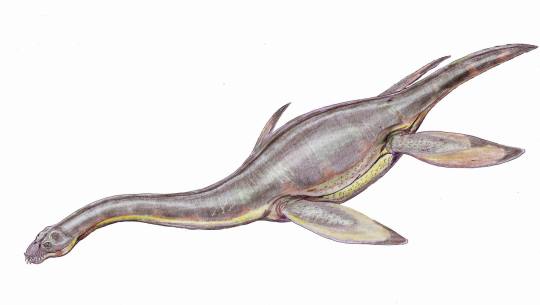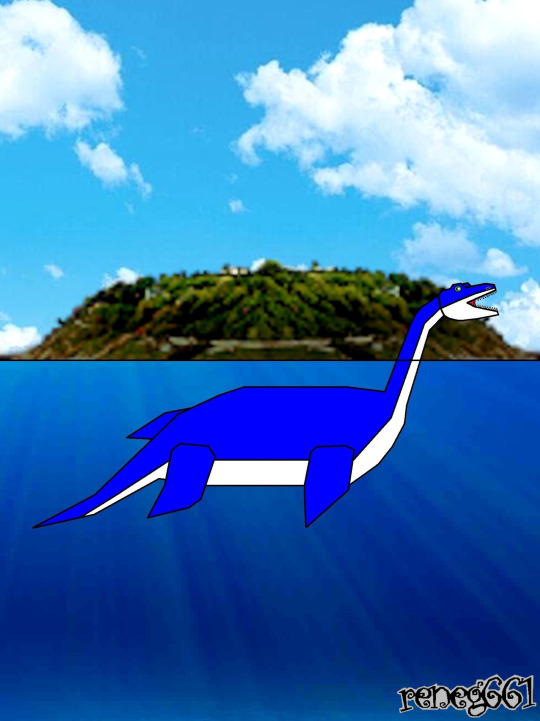#seeleyosaurus
Photo

Seeleyosaurus guilelmiimperatoris here was a smallish plesiosaur (about 3.5m long / 11'6") found in Germany during the early Jurassic, about 182 million years ago.
And back in the 1890s, a specimen of this species was discovered with soft tissue impressions showing a diamond-shaped tail fin.
But despite us knowing about plesiosaur tail flukes for such a long time, they're surprisingly under-represented in reconstructions, never seeming to have become associated with the popular image of these animals in the same way that early pterosaur's tail vanes did. It doesn't help that no other direct impressions of plesiosaur tail fins have ever been found, or that the Seeleyosaurus specimen's soft tissue got painted over at some point in the mid-1900s, making it incredibly difficult to study without causing further damage.
(Perhaps modern non-invasive scanning techniques could be able to see under the paintjob, but as far as I'm aware nobody's tried that yet.)
These tail fins are usually assumed to have been vertically oriented like those of other aquatic reptiles, moving side-to-side and acting like a rudder. However, there's also a hypothesis that their fins might have actually been horizontal more like those of modern cetaceans and sirenians, based on several anatomical quirks – such as their tail regions being very wide and flat at the base, and the vertebrae at the tip being unusually pygostyle-like, very different from the way the tail bones of vertically-finned reptiles look.
———
Nix Illustration | Tumblr | Pillowfort | Twitter | Patreon
#science illustration#paleontology#paleoart#palaeoblr#seeleyosaurus#microcleididae#plesiosaur#sauropterygia#pantestudines#archosauromorpha#reptile#marine reptile#art#chub-blubs#yeah let's just PAINT OVER the only plesiosaur tail fin impression ever found#it's not important or anything#😒
368 notes
·
View notes
Text
Hydrorion brachypterygius

Art by: Dmitry Bogdanov, CC BY 3.0
Name: Hydrorion brachypterygius
Name Meaning: Water hunter
First Described: 2006
Described By: Grossmann et al.,
Classification: Chordata, Tetrapoda, Reptilia, Sauropterygia, Plesiosauria, Plesiosauridae
Hydrorion was once thought to be another species of Plesiosaurus, but in 2006 it was realized to be a completely separate genus. Anyways, Hydrorion existed during the Early Jurassic and paleontologists discovered it in Germany’s Posidonia Shale formation. Another plesiosaur, Seeleyosaurus guilelmiimperatoris was also found in this same formation.
Sources:
https://en.wikipedia.org/wiki/Hydrorion
#Hydrorion#palaeoblr#paleontology#palaeontology#prehistoric#Mesozoic#ancient marine reptiles#Not a dinosaur#sauropterygia
35 notes
·
View notes
Note
No, Plesiosaurs couldn't bend their necks into a vertical swanlike pose. Also, the front flipper/shoulder area might need more muscle. And the tail might need a fin on it. Depends. Some Plesiosaurs show tail fins(Seeleyosaurus had an impression,Cryptoclidus and Muraenosaurus have osteological correlates for a tail fin) but others (Mauriciosaurus) don't. Might have been a matter of phylogeny.
This is very good to know! Plesiosaurs are definitely not my specialty.
21 notes
·
View notes
Photo

Is a genus of extinct, large marine sauropterygian reptile that lived during the early part of the Jurassic Period, and is known by nearly complete skeletons from the Lias of England. It is distinguishable by its small head, long and slender neck, broad turtle-like body, a short tail, and two pairs of large, elongated paddles. It lends its name to the order Plesiosauria, of which it is an early, but fairly typical member. It contains only one species, the type, Plesiosaurus dolichodeirus. Other species once assigned to this genus, including P. brachypterygius, P. guilielmiiperatoris, and P. tournemirensis have been reassigned to new genera, such as Hydrorion, Seeleyosaurus and Occitanosaurus.
Carnivore
Art (c) reneg661
3 notes
·
View notes